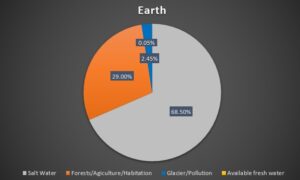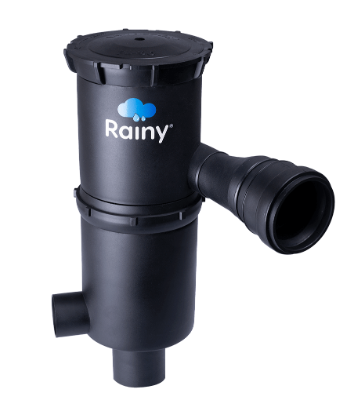
Readers like you help support Lifespectrum360.com. When you purchase using links on our site, we may earn an affiliate commission. Read More.
Unlock The Hidden Treasure: Importance of Rainwater Harvesting
Did you know that a single centimeter of rainfall on a 1,000-square-foot roof can yield around 900 liters of water? Explore some more interesting facts about the importance of rainwater harvesting and how a rainwater harvesting project can give a fresh lifeline to communities around the world.
The Water Crisis
You must have known that around 70% of the earth’s surface is covered with water. We need not worry about water scarcity because there is so much water that we need not worry about for the next 100 years.
But if we say that only 0.05% of the water is available for human consumption, you will be completely shocked, right!!
Yes. You read it right.
As per USGS data, Oceans hold 97% of the water on the earth which is salty and unfit for direct consumption. As per USBR data, 2.5% of the remaining fresh water on the planet is inaccessible because it is trapped in glaciers, polar ice caps, the atmosphere, and soil; It is either extremely contaminated or too deep to be removed for a fair price.
You can visualize the above statistics more clearly If we say this:
“If the world’s total water supply were merely 100 liters (26 gallons), our usable freshwater supply would only be about 0.003 liters (one-half teaspoon).”
What is Bothering Now?
You may think, what is the new thing in the above information? They are present for ages. Why are we bothered to think about it now?
Answer lies –
- With increasing industrialization, water gets polluted and becomes unfit for consumption.
- With population growth and increasing needs for well-being, we need more water.
- Rainfalls are decreasing over time.
Results:
As per WorldBank data, approximately 66% of the total world population resides in water basins that experience water stress for at least some part of the year.
What is The Solution – Importance of Rainwater Harvesting
Rainwater Harvesting is one of the practical and speedy answers to this looming crisis. Initially, we said just one centimeter of rainfall on a 1000-square-foot rooftop area can collect around 900 liters of water. This would mean that one person can manage with this rainwater for around one week without depending on any other water source. Sounds Interesting now!!
Rainwater Harvesting in Simple Terms?
Imagine this: You’re standing outside on a rainy day, and the water from the sky is pouring down. Instead of letting all that precious rainwater go to waste, you can collect it for later use. That’s where rainwater harvesting comes in! So simple!!
Yes. That’s right.
Four Basic Principles to Realize the Importance of Rainwater Harvesting
- Collection: Imagine your roof is like a big umbrella. When it rains, water slides down your roof and into the gutters. The first step is to collect this rainwater. Channels are like the rainwater’s slide, guiding it to a particular spot.
- Filtration: Rainwater isn’t as pure as a mountain stream; it can have bits of leaves and dirt from your roof. So, we need to clean it up. You can set up filters or mesh screens in your gutters or at the entry point of your rainwater storage tank to catch these impurities.
- Storage: Once your rainwater is clean, you need somewhere to keep it until you’re ready to use it. This is where storage tanks come in. These tanks can be above or below ground and come in different sizes to fit your needs.
- Distribution: When you’re ready to use your harvested rainwater, you’ll need a way to get it where you want it. You can connect pipes from your storage tanks to areas like your garden, toilets, or even your washing machine.
Icing on The Cake – Importance of Rainwater Harvesting is Incomplete Without Economic Benefits
- Reduced Water Bills: You can save around 20% on your monthly water bills if you use harvested rainwater for non-potable uses like watering your garden, flushing toilets, or washing your car.
- Reduced Electricity Bills: Most of the places, bore wells meet the water requirement of individual or society buildings. In rainy season, if rain water is harvested properly, then an immediate annual savings on electricity charges will be around 25%.
- Lower Sewerage Charges: In many places, sewerage charges are based on the volume of water you use. When you use harvested rainwater for non-drinking purposes, you’ll reduce the amount of wastewater entering the sewer system. This can result in lower sewerage charges on your utility bill, further adding to your financial savings.
- Improved Water Quality: Rainwater is relatively pure and soft, making it suitable for a range of applications like drinking, bathing and washing clothes, without the need for expensive water treatment processes.
- Government Incentives and Rebates: In some regions, there are government incentives and rebates available for installing rainwater harvesting systems. They can help offset the initial installation costs to some extent and provide additional savings. Check with local authorities to see if such programs exist in your area.
- Increased Property Value: A rainwater harvesting system can enhance the resale value of your property by around 10-15%. As climate change is more of a reality now, many home buyers are increasingly interested in eco-friendly and sustainable features especially lower dependence on outside sources of water like municipal bodies, tankers or bore wells.
conclusion
We hope you have understood the importance of rainwater harvesting. Conserving water through rainwater harvesting is not just a choice but a responsibility we all share. With the full understanding of the importance of rainwater harvesting, you have taken the first step towards fulfilling your environmental responsibility and ready to enjoy a host of financial benefits that come along with it.
For more details on the importance of rainwater harvesting and case study, stay tuned to our Environmental Blogs.
Share your comments in the comment box below about your experiences, challenges you have faced in implementing a rainwater harvesting project, or any feedback on the article.
Read our other useful bogs:

